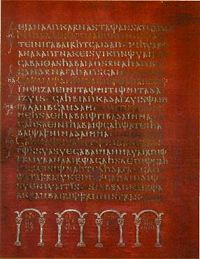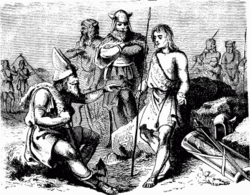Wulfila
Wulfila (Gothic: "little wolf" or Latin: Ulfilas/Ulphilas; c. 311 - 380 C.E.), was the apostle of the Goths, missionary, translator of the Bible, and inventor of the first Gothic alphabet. Probably descended from Christian exiles captured by the Gothic in Europe, he was sent to Rome as a young man and was ordained a bishop by Eusebius of Nicomedia at the height of the Arian controversy. He then returned to his people to work as a missionary.
In 348, to escape religious persecution by a Gothic chief, probably Athanaric, he obtained permission from Emperor Constantius II to immigrate with part of his flock of converts to Moesia and settle near Nicopolis ad Istrum, in what is now northern Bulgaria. Others among his converts became martyrs to their faith, a form of Arian Christianity.
In Moesia, Ulfilas translated the Bible from Greek into the Gothic language after devising the first Gothic alphabet. He later participated in the Semi-Arian church council at Constantinople in 360, which attempted to solve the conflict between Arian and Nicene Christians by forbidding the previous creeds of both factions.
Ulfilas converted many among the Goths and other Teutonic peoples. preaching an Arian Christianity, which, when they reached the western Mediterranean, set them apart from their "orthodox" (i.e. Trinitarian) neighbors and subjects. Emperor Constantius II reportedly called him "the Moses of his day."
Biography
Born probably in 311 Ulfilas was descended from Cappadocians captured, during raids in Asia Minor by the Goths from the north of the Danube. According to fragments of the Cappadocian church historian Philostorgius, preserved by Saint Photius of Constantinople, the Goths, during the time of Emperor Valerian, took many Christian prisoners, probably including Ulfilas' ancestors. Though not from Teutonic ancestors, in speech and sympathies was thus thoroughly Gothic. As a young man he was sent by the Goths to Constantinople reportedly as an ambassador, though possibly as a hostage. There, he held the position of lector in the church of Constantinople and was consecrated as a bishop at the age of 30 the celebrated Eusebius of Nicomedia, a celebrated Arian leader with high connections in the imperial court.
Shortly after his consecration, he returned to Dacia as a missionary. During the remaining 40 years of his life he labored among his fellow countrymen, teaching them the Christian faith, though not adhering to the Nicene Creed.
The first eight or ten years of his missionary life were spent in Dacia, after which, because of the persecution of certain of his pagan countrymen, he was compelled to seek refuge in Moesia, along with many of his Christian converts. The church historian Socrates Scholasticus attributes to Ulfilas the conversion of many of the Goths under the leadership of both Fritigernes and Athanaric. The latter, says Socrates, regarded this as "a violation of the privileges of the religion of his ancestors." Socrates is thus forced to admit that, under Ulfilas' influence "many of Arian Goths of that period became martyrs." (Church History Book IV)
In Moesia, he conceived the idea of translating the Bible into the language of the Goths. The task demanded as a preliminary that he should invent a special alphabet. His familiarity with Greek made the task comparatively simple, with only a few letters being borrowed from other sources, either Runic or Latin.
Despite his many other activities, Ulfilas succeeded in translating "all the books of Scripture with the exception of the Books of Kings, which he omitted because they are a mere narrative of military exploits, and the Gothic tribes were especially fond of war, and were in more need of restraints to check their military passions than of spurs to urge them on to deeds of war" (Philostorgius, "Hist. eccl.", II, 5). He translated the books of the Old Testament from the Septuagint Greek version, and those of the New Testament from the original Greek.
Ulfilas was one of the bishops in attendance at the major church council at Constantinople in 360, where Bishop Acacius of Caesarea triumphed and the council issued its compromise creed as a substitute for the formulas of both the Nicene and the Arian parties. In an effort to end the bitter acrimony between the conflicting sects, the council decreed that neither the word "substance" (ousia) nor hypostasis (translated as "persona" in Latin) be used in theological creeds henceforth. The policy failed to win over the extreme partisans of either camp and was especially offensive to the Nicene party since it abrogated the canons of a previous ecumenical party.
From this point on, Ulfilas would be considered by "orthodox" Christianity to be either an Arian or semi-Arianism Semi-Arian heretic. The more sympathetic Philostorgius adds that no less a personage that the Roman emperor himself "held Urphilas himself in such high honor that he would often speak of him in conversation as 'the Moses of his day.'"
The testimony of Auxentius
The most detailed description of Ulfilas' life comes from a letter of Auxentius of Milan, characterized by "orthodox" sources as an Arian bishop placed in his see after his predecessor resisted the policy of Constanius II to refrain from promoting either overtly Nicene or Arian positions. Auxentius, who had been Ulfilas' disciple, not surprisingly portrays him not as an Arian per se, but probably as a semi-Arian who supported the council of Constantinople's view that neither homousios (same substance: the Nicene word) nor homoiousos (like substanc: the Arian word) should be used to describe the relationship between God the Father and God the Son.
Auxentius declared Ulfilas to be "verily a confessor of Christ, a teacher of piety and a preacher of truth," who never hesitated to preach the Gospel to people of all ranks. Auxentius credits Ulfilas with "scatter(ing) the sect of the Homousians (Nicene Christianity), because he believed not in confused and concrete persons, but in discrete and distinct ones." On the other, Ulfilas also put put the Homoiousians (Arians) to flight, "since they defended the assumption that they (the Son and the Father) were not of comparable but different substance."
Other heretics which Auxentius credits Ulfilas with opposing include: Manichaeans, Marcionists, Montanists, Novatianists, and Donatists, among others.
Auxentius further testifies that "by the kindness of God and the grace of Christ he reared me bodily and spiritually as a son in the faith." He concludes his account be appending Ulfilas' personal creed, which reads as follows:
I, Ulfila, bishop and confessor, have always so believed, and in this, the one true faith, I make the journey to my Lord; I believe in one God the Father, the only unbegotten and invisible, and in his only-begotten son, our Lord and God, the designer and maker of all creation, having none other like him (so that one alone among all beings is God the Father, who is also the God of our God); and in one Holy Spirit, the illuminating and sanctifying power, as Christ said after his resurrection to his apostles: "And behold, I send the promise of my Father upon you; but tarry ye in the city of Jerusalem, until ye be clothed with power from on high" (Luke 24:49) and again "But ye shall receive power, when the Holy Ghost is come upon you" (Acts 1:8); being neither God (the Father) nor our God (Christ), but the minister of Christ... subject and obedient in all things to the Son; and the Son, subject and obedient in all things to God who is his Father... (whom) he ordained in the Holy Spirit through his Christ.[1]
Legacy
Has he not sided with the losing party in the theological controversy of his day, Ulfilas may have been known as one of the greatest saints in history. He courageously brought to Gospel to the Goths, instilling in them a faith that led many of them to accept martyrdom. Although condemned in most histories as "barbarians," the Gothic tribes who overtook Europe and eventually captured even Rome itself were in reality not pagans, but Arian Christians, due largely to Ulfilas' influence.
The Goths tended not to interfere in the theological affairs of the Christians of the Roman empire. Ironically, this aided the Catholic Church immensely by allowing it to develop relatively free from state influence, providing a much-needed counterbalance to the meddling of the eastern Roman emperors at Constantinople, who sought to use the Christian religion as an instrument of the state.
Theologically, Ulfilas' legacy was ultimately wiped out by the resurgence of Nicene orthodoxy and the demise of both Arian and Semi-Arian Christianity. A more lasting contribution is his invention of a Gothic alphabet and his translation of the Bible into the previouly unwritten Gothic language. A few chapters of Ulfilas's translation of the Old Testament are still in existence. Of the New Testament the greater portion of the Gospels have been maintained in the beautiful Silver Codex (a purple parchment with silver and gold letters) now at Upsala, dating from the fifth century. Nearly all of his translations of Saint Paul's epistles can still still be found in a Milanese codex as well.
See also
- Attila
- Gothic Christianity
- Germanic Christianity
Notes
- ↑ Heather and Matthews, Goths in the Fourth Century, p. 143.
ReferencesISBN links support NWE through referral fees
External links
- Jim Marchand's translation on Auxentius' letter on Ulfilas' career and beliefs, with Latin text
- Project Wulfila
Credits
New World Encyclopedia writers and editors rewrote and completed the Wikipedia article in accordance with New World Encyclopedia standards. This article abides by terms of the Creative Commons CC-by-sa 3.0 License (CC-by-sa), which may be used and disseminated with proper attribution. Credit is due under the terms of this license that can reference both the New World Encyclopedia contributors and the selfless volunteer contributors of the Wikimedia Foundation. To cite this article click here for a list of acceptable citing formats.The history of earlier contributions by wikipedians is accessible to researchers here:
The history of this article since it was imported to New World Encyclopedia:
Note: Some restrictions may apply to use of individual images which are separately licensed.

